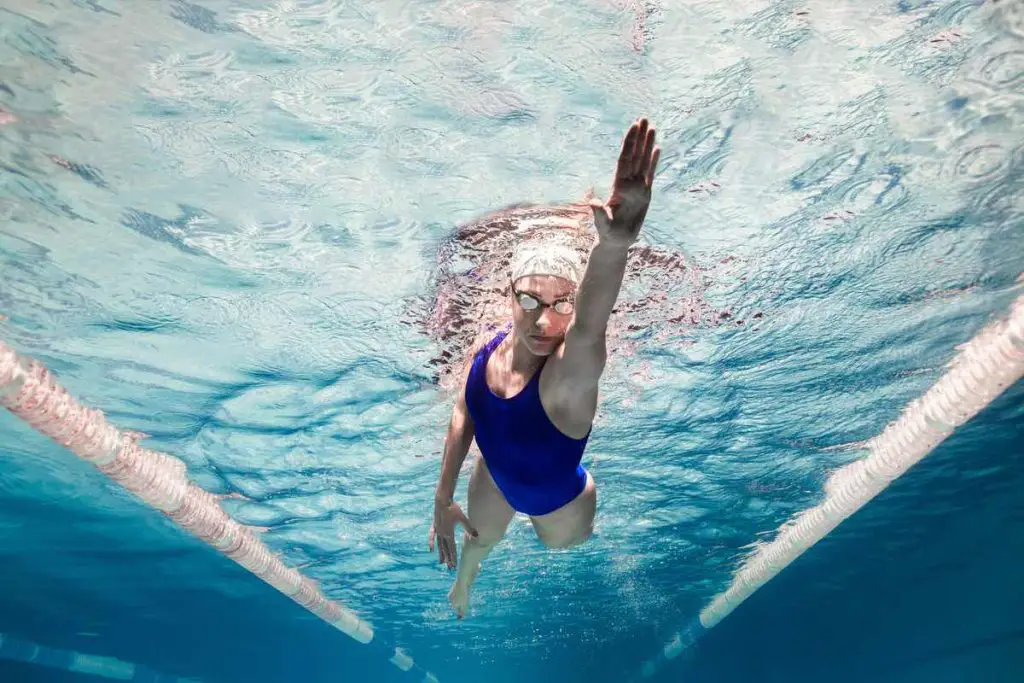Endurance athletes have long debated which is more difficult: swimming or running. While the answer is not so straightforward, people tend to say swimming is the more difficult sport.
Competitive swimming is more challenging than running because of the human body shape and the resistance that water provides. Our bodies evolved for running, whereas swimming presents more challenges. When swimming, breathing is limited, and more muscle groups and skills are required.
While this may be the consensus, the question is still widely debated. In this article, I’ll break down the arguments for each side so you can decide which you feel is harder.

Why Swimming Is Harder Than Running
There are a few primary reasons most people feel swimming is the more challenging sport. Let’s look at them now.
The Human Body Was Designed To Run, Not Swim
The human body was designed to run.
Humans evolved over time to develop better running abilities. Longer legs, bigger glutes, and more petite feet all make running more efficient.
Back when humans had to hunt for survival, they would need to run for long periods. While they may not be able to overpower some animals, they are designed to outlast them on a long chase. When the animals tired of running, they would eventually give up, making it possible for humans to attack their prey.
Humans have been runners for about 2 million years, while historians believe humans only started swimming around 3,000 years ago. There may have been a food shortage, causing humans to get desperate and start swimming to hunt for food. However, our bodies have not evolved to swim, making it more difficult.
Swimming Is a Total Body Workout
Since swimming is not a natural movement for humans, it requires potentially awkward movements. You need to use more muscles and energy to stay afloat than you would to simply stand.
Running is primarily a lower body activity. People use five major muscle groups for running: quads and hip flexors, hamstrings, glutes, calves, and core muscles.
However, swimmers can use up to 50 muscles when in the water. To power your upper body, you’ll need most of your upper body muscles—including your hands. Meanwhile, you’ll use your core muscles and lower body for stabilization and kicking power.
Overall, swimming involves many more muscle groups. Swimming is a total body workout, while running is primarily a lower body one.
Swimming Strokes Require More Skill
To be a competitive runner, you must train specific muscles and practice different techniques. However, running is still an intuitive movement. Kids learn to run without necessarily being taught.
To swim, kids usually start off dog paddling. However, they’ll eventually need to know specific strokes if they want to move faster. Kids often take lessons to learn how to swim correctly.
Competitive swimmers also learn various strokes to move through the water. These strokes aren’t always natural at first, but they take time and practice. Because swimming is less intuitive, there is a more significant learning curve, making it harder overall.
Breathing Is Limited When Swimming
Another aspect that makes competitive swimming more challenging is breathing.
We need air to breathe. If running on land, this is not an issue. However, while swimming, you’re forced to hold your breath and come up for air periodically.
Learning to breathe when swimming is a skill that takes effort. It can also increase your lungs’ demand, strengthening them over time.
People Can Run Faster Than They Can Swim
It’s well known that people run faster than they can swim. The resistance of land, gravity, and air is minimal compared to water resistance.
When comparing competitive times in both sports, it is estimated athletes run 3.63x faster than they swim. This means that for every 1 mile (1.62 km) swam, they can run 3.63 miles (5.84 km).
While these statistics differ depending on individual strengths, it’s safe to say most people can run faster than they can swim.
Water Is Denser Than Air
A big reason runners move more quickly is because it’s easy to move through the air.
However, water is much denser than air. Water provides resistance we are not used to. As a result, we have to use extra effort to push through it.
Why Running Is Harder Than Swimming
Let’s look at a few arguments for why running is more difficult than swimming.
Running Is Harder on Joints
Swimming is easier on the joints than running. Since running requires pushing off the ground, it’s a high-impact activity. Over time, this can wear on the cartilage in your joints, especially your knees.
While it might be hard to move through water, you don’t actually come into contact with hard surfaces. This makes it a low-impact activity. You’re moving lots of joints without the impact of a hard surface.
So, while swimming may require more effort and skill overall, running actually causes more wear and tear on the body.
Running Burns More Energy Per Hour
Our bodies are constantly expending energy to eat, breathe, exercise, and even sleep. Some activities put a higher demand on our bodies, requiring more energy.
Energy is measured in calories. Higher intensity activities mean we burn more calories. So which sport burns more calories (and therefore, requires more energy): swimming or running?
According to a Harvard study, the energy expended during 30 minutes of each sport is as follows:
| Sport | Calories burned by a 155 lbs person |
| Swimming leisurely | 216 |
| Running (5mph) | 288 |
| Swimming vigorously | 360 |
| Running (7.5 mph) | 450 |
Of course, the terms “leisurely” and “vigorous” are subjective. While it would be better to analyze with actual speeds, the pattern is clear.
Competitive running burns more calories per 30 minutes than swimming. Furthermore, that gap increases the faster someone runs. Competitive runners would probably run faster than 7.5 miles per hour, which would burn even more calories than competitive swimmers.
Because runners burn more calories than swimmers, you could say running is more challenging.

Conclusion
While there’s no clear-cut answer, most people would say competitive swimming is more difficult than running. However, both sports are a great way to stay fit. However, competitive swimming may require more skill and overall effort compared to running.
Running burns more calories and may be easier to pick up for a novice, as it’s a more natural human movement. However, don’t forget to go easy on those joints if you decide to pick up this sport!
Sources
- National Geographic: Humans Were Born to Run, Fossil Study Suggest
- The New York Times: Amphibious Man; Humans aren’t really designed for swimming, but we do an awful lot of it
- National Insititute of Health: Evolutionary Basis of Running and Its Impact on Neural Function
- The New York Times: Run vs. Swim? Statistician Says the Score Is in
- Fit Active Living: What Muscles Are Used in Swimming?
- Harvard Health: Calories burned in 30 minutes of leisure and routine activities
